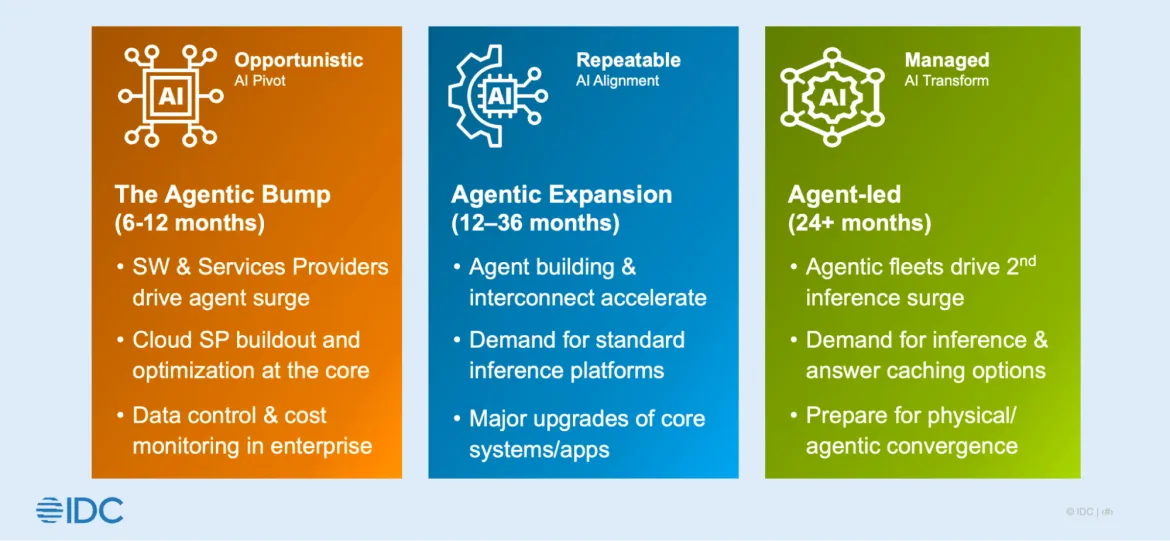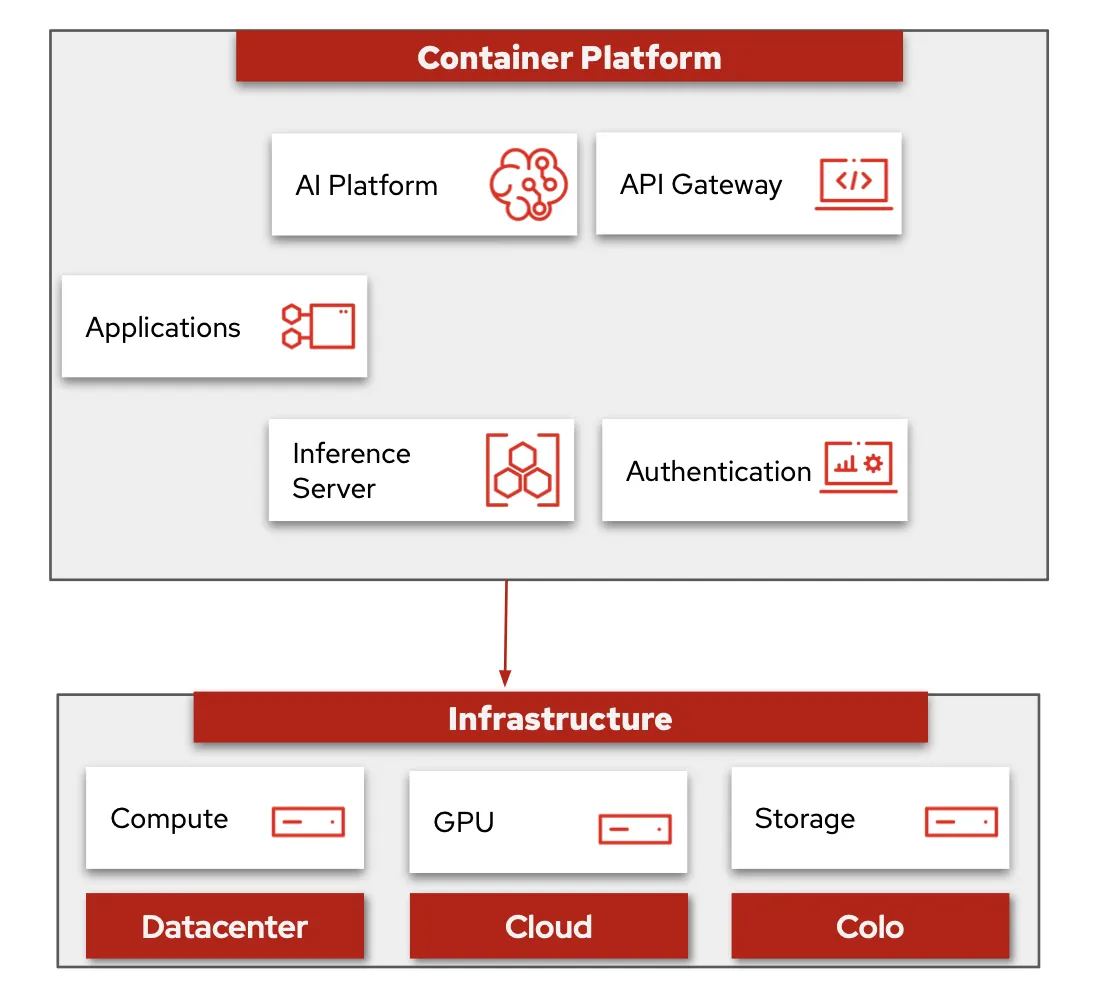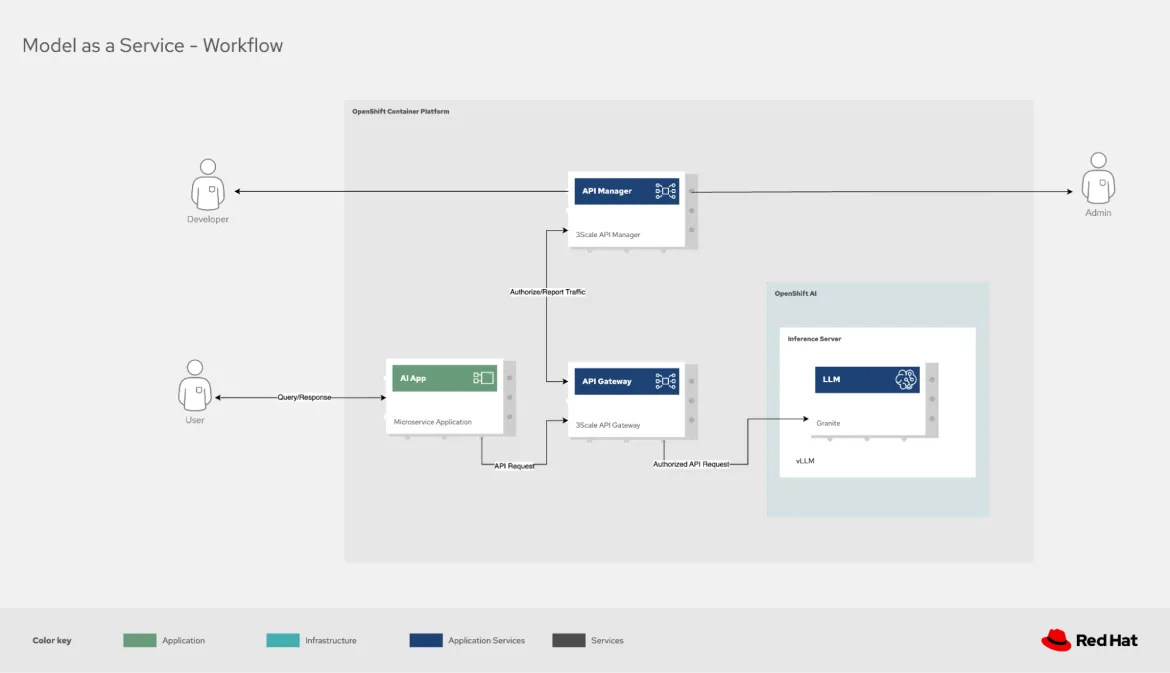As AI solutions accelerate across enterprises, it becomes increasingly expensive to use public models, which have the added risk of enterprise data potentially being exposed to third parties. The Models-as-a-Service (MaaS) approach enables enterprises to offer open source models (and the required AI technology stack) that can be used as a shared resource by the entire company.
Additionally, as an enterprise's AI adoption accelerates, there’s often a lack of consistency as each business group strives to build their own bespoke AI solutions covering a wide range of use cases (Chatbot, code assistant, text/image generation, etc.).
IDC’s insights on AI adoption trends describes how enterprises transition from opportunistic to managed solutions that can transform the entire organization.

Each business group often requires different types of AI models to address their specific use cases. Here are a few examples:
- Generative AI (gen AI) models: Used to create new content, such as text or images
- Predictive AI models: Used to classify or predict patterns in data
- Fine-tuned AI models: These are models customized with company or domain-specific data
- Retrieval-augmented generation (RAG): This enhances generic model information with company or domain-specific data
Gen AI models that can be accessed through third-party hosted services, like OpenAI, Claude and Gemini, are easy to get started with but become very expensive when used at scale. There are also data privacy and security issues as the enterprise data may be exposed to these other parties. Gen AI and other models can also be self-hosted by the enterprise, but this can lead to a duplication of effort across various business groups resulting in increased costs and time to market.
With new gen AI models being released every other week and the speed of AI advancements, it’s becoming nearly impossible for enterprises to keep up. There are dozens of options for models, from very large size (450B parameters) to smaller versions of these models (quantized or fewer parameters) to a mixture of expert models. Many developers lack the expertise needed to choose the right model or to make optimal use of expensive resources (e.g. GPUs).
With each business group building their own AI solutions, enterprises face several challenges:
- High costs: Deploying and maintaining AI models requires expensive GPU clusters, machine learning (ML) expertise and ongoing fine-tuning. Training and fine-tuning models in-house can cost millions in compute, storage and talent. Additionally, the model costs can become unpredictable without centralized governance.
- Duplication: Duplication or underutilization of scarce AI resources can lead to wasted budgets.
- Complexity: Developers just want access to the model and don’t want to deal with infrastructure complexity or continually evolving AI stack.
- Skill shortage: Enterprises lack the ML engineers, data scientists and AI researchers that are needed to build custom models.
- Operational control: As multiple groups work on their own independent AI efforts, enterprises struggle with scaling, version control and model drift.
There needs to be a better approach for enterprises to take advantage of AI momentum without breaking the bank.
MaaS to the rescue
MaaS enables enterprises to offer open source models (and the required AI stack) that can be used as a shared resource. In effect, enterprise IT becomes the service provider of AI services that can be consumed by the entire company.
Users can choose from state-of-the-art frontier models to quantized or small language models (SLMs) that are orders of magnitude smaller but provide similar performance at a fraction of the cost. The models can be tuned and customized with private enterprise data and can run on less powerful hardware, consuming less energy. There can be multiple instances of models to address different use cases and deployment environments. All of these models are served efficiently to make most of the available hardware resources.
The models can be easily accessed by developers who can now focus on building AI apps and don’t have to be concerned with the underlying infrastructure complexities (e.g. GPUs).
Enterprise IT can monitor model usage by various business groups and charge back for their consumption of AI services. IT can also apply AI management best practices to streamline model deployment and maintenance (e.g. versioning, regression testing).

Here are some of the advantages of IT becoming the private AI provider for the enterprise:
- Reduced complexity: Centralized MaaS helps eliminate AI infrastructure complexity for users
- Lower costs: Helps reduce costs by centrally serving model inference services
- Increased security: Compliance with existing security, data and privacy policies by not using third-party hosted models
- Faster innovation: Faster model deployment and innovation around it result in faster time to market for AI applications
- Non-duplication: Avoids duplication of scarce AI resources across various groups—data scientists can provide optimized models needed for common enterprise tasks
- Freedom of choice: Eliminates vendor lock-in while keeping AI workloads portable
Looking under the MaaS hood
This MaaS solution stack consists of Red Hat OpenShift AI, API Gateway (part of Red Hat 3scale API Management) and Red Hat single sign-on (SSO). It delivers end-to-end AI governance, zero-trust access (Red Hat build of Keycloak), an AI Inference server (vLLM) and hybrid cloud flexibility (OpenShift AI) on a single platform. It also uses consistent tooling to deploy the solution on-prem and to the cloud with Red Hat OpenShift.

Let’s look at each of these components in more detail.
API Gateway
API Gateway provides enterprise-grade model API control. This solution stack is based on 3Scale API Gateway, but any enterprise grade API Gateway can be used instead. Here are some of the benefits of this API Gateway:
- Security and compliance
- Enforce API authentication via JWT/OAuth2 for LLM access
- Encrypt all API traffic to/from LLM services
- Audit logs for compliance (GDPR, HIPAA, SOC2)
- Usage optimization
- Set rate limits and quotas to prevent cost overruns
- Monitor LLM API consumption by team/project
- Identify unused or overused endpoints
- Hybrid deployment support
- Manage APIs consistently across cloud/on-prem (via OpenShift integration)
- Deploy dedicated API gateways for private LLM instances
- Developer enablement
- Self-service developer portal for LLM API discovery
- Automated API documentation and testing
- OpenShift AI integration
- Enforce governance for models deployed on OpenShift AI
- Track AI/ML API usage alongside traditional services
Authentication
The authentication component provides unified identity management for LLM services. This solution stack is based on Red Hat SSO but any other enterprise grade authentication solution can be used instead. Here are some of the benefits of authentication:
- Zero-trust security
- Centralized authentication for all LLM tools (OIDC/SAML)
- Role-based access control (RBAC) for fine-grained permissions
- Multifactor authentication (MFA) support for sensitive AI workloads
- Enterprise identity integration
- Connect to Active Directory, LDAP or other identity providers
- Automate user provisioning/deprovisioning
- Scalable access management
- Single sign-on for all internal AI portals
- Session management for compliance
- Hybrid cloud-ready
- Secure access to LLMs running anywhere (public cloud/on-prem)
- Consistent policies across environments
OpenShift AI integration
- SSO for OpenShift AI dashboards and model endpoints
- Unified identity for both platform users and API consumers
Inference server
This solution stack uses vLLM as the inference server. The vLLM framework supports multimodal models, embeddings and reward modeling, and is increasingly used in reinforcement learning with human feedback (RLHF) workflows. With features such as advanced scheduling, chunk prefill, Multi-LoRA batching and structured outputs, vLLM is optimized for both inference acceleration and enterprise-scale deployment.
vLLM also provides LLM compression tools so customers can optimize their own tuned models.
AI platform
This solution stack uses OpenShift AI to serve models and deliver innovative applications. OpenShift AI helps enterprises with all aspects of AI, including data acquisition and preparation, model training and fine-tuning, model serving and model monitoring and hardware acceleration.
The latest release of OpenShift AI is designed to increase efficiency by providing access to smaller, pre-optimized models. Additionally, it helps manage inferencing costs with distributed serving through a vLLM framework.
OpenShift AI is offered as either self-managed software or as a fully managed cloud service on top of OpenShift and provides a secure and flexible platform that gives you the choice of where you develop and deploy your models–whether on-premise, in the public cloud or even at the edge.

Final thoughts
As enterprises build and scale various AI solutions, using third-party hosted models is becoming very expensive and includes often unacceptable data privacy risks as enterprise data is exposed to these third parties. Self-hosting AI models can help address data privacy but can also result in duplicative efforts across various business groups, increasing costs and slowing time to market.
Models-as-a-Service (MaaS) is a new approach that enables enterprises to provide open source models that can be used as a shared resource across the entire company. These models can be conveniently accessed by developers who can now focus on building AI apps without having to worry about the underlying infrastructure. Enterprise IT can monitor model usage by various business groups and charge each team or project back for their consumption of AI services.
The MaaS approach allows enterprises to move from one-off AI opportunities to transform the AI capabilities of the entire organization.
Learn more
- Check out the MaaS Solution Architecture for more information or get a quick visual walkthrough of the solution.
- Visit Model as a Service Repository to setup your own MaaS solution.
- Contact Red Hat Consulting for additional services.
- Learn about the benefits of quantization.
- Watch InstructLab in action.
1 IDC Directions, Completing the Agentic Journey, April 2025
product trial
Red Hat Enterprise Linux AI | Product Trial
About the authors
Ishu Verma is Technical Evangelist at Red Hat focused on emerging technologies like edge computing, IoT and AI/ML. He and fellow open source hackers work on building solutions with next-gen open source technologies. Before joining Red Hat in 2015, Verma worked at Intel on IoT Gateways and building end-to-end IoT solutions with partners. He has been a speaker and panelist at IoT World Congress, DevConf, Embedded Linux Forum, Red Hat Summit and other on-site and virtual forums. He lives in the valley of sun, Arizona.
Ritesh Shah is a Principal Architect with the Red Hat Portfolio Technology Platform team and focuses on creating and using next-generation platforms, including artificial intelligence/machine learning (AI/ML) workloads, application modernization and deployment, Disaster Recovery and Business Continuity as well as software-defined data storage.
Ritesh is an advocate for open source technologies and products, focusing on modern platform architecture and design for critical business needs. He is passionate about next-generation platforms and how application teams, including data scientists, can use open source technologies to their advantage. Ritesh has vast experience working with and helping enterprises succeed with open source technologies.
Juliano Mohr is a Principal Architect at Red Hat, where he builds demos, labs, and workshops for the Red Hat demo platform. He was previously a Consulting Architect at Red Hat, applying his expertise in application development to support digital transformation. During his global career, he has deepened his knowledge in agile, DevOps, and modern software practices.
Browse by channel
Automation
The latest on IT automation for tech, teams, and environments
Artificial intelligence
Updates on the platforms that free customers to run AI workloads anywhere
Open hybrid cloud
Explore how we build a more flexible future with hybrid cloud
Security
The latest on how we reduce risks across environments and technologies
Edge computing
Updates on the platforms that simplify operations at the edge
Infrastructure
The latest on the world’s leading enterprise Linux platform
Applications
Inside our solutions to the toughest application challenges
Virtualization
The future of enterprise virtualization for your workloads on-premise or across clouds


